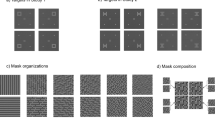Abstract
The role of parts versus that of wholes in a visual perception has been debated for a century as two opposite approaches, namely, an analytic and holistic. In two psychophysical experiments we investigated whether the stimulus completeness or distinctiveness is essential for identification of the partially presented patterns under brief presentation conditions. For this purpose, a special class of stimuli was constructed in such a way that the patterns could be divided into informative and redundant parts. The first experiment clearly demonstrated the importance of the redundant part for effective pattern identification for the majority of subjects. The second experiment revealed the direct dependence of identification accuracy of the patterns on their completeness (2, 3, 4, 5, or 6 elements). Familiarisation of subjects with the test stimuli influenced the strength of this dependence.





Similar content being viewed by others
References
Bergevin R, Levine MD (1993) Generic object recognition: building and matching course descriptions from line drawings. IEEE Trans Pattern Anal Mach Intell 15:19–36
Biederman I (1986) Recognition by components: a theory of visual pattern recognition. Psychol Learn Motiv 20:1–54
Biederman I (1987) Recognition-by-components: a theory of human image understanding. Psychol Rev 94:115–147
Biederman I, Kalocsai P (1997) Neurocomputational bases of object and face recognition. Philos Trans R Soc Lond B Biol Sci 352:1203–1219
Biederman I, Subramaniam S, Bar M, Kalocsai P, Fisher J (1999) Subordinate-level object classification reexamined. Psychol Res 62:131–153
Cave CB, Kosslyn SM (1993) The role of parts and spatial relations in object identification. Perception 22:229–248
Cooper LA (1976) Individual differences in visual comparison processes. Percept Psychophys 19:433–444
Cooper LA (1980a) Recent themes in visual information processing: a selected overview. In: Nickerson RE (ed) Attention and performance, vol VII. Lawrence Erlbaum Associates, Hillsdale, pp 319–345
Cooper LA (1980b) Spatial information processing: strategies for research. In: Snow R, Federico P-A, Montague WE (eds) Aptitude, learning, and instruction: cognitive process analyses, vol I. Lawrence Erlbaum Associates, Hillsdale, pp 149–176
Edelman S (1997) Computational theories of object recognition. Trends Cogn Sci 1:296–304
Edelman S (1998) Representation is representation of similarity. Behav Brain Sci 21:449–498
Gibson FJ (1969) Principles of perceptual learning and development. Appleton-Century-Crofts, New York
Hummel JE (2000) Where view-based theories break down: the role of structure in shape perception and object recognition. In: Dietrich E, Markman A (eds) Cognitive dynamics: conceptual change in humans and machines. Erlbaum, Hillsdale, pp 157–185
Hummel JE (2001) Complementary solutions to the binding problem in vision: implications for shape perception and object recognition. Vis Cogn 8:489–517
Hummel JE (2003) The complementary properties of holistic and analytic representations of shape. In: Peterson MA, Rhodes G (eds) Perception of faces, objects, and scenes: analytic and holistic processes. Oxford University Press, Oxford, pp 212–234
Hummel JE, Biederman I (1992) Dynamic binding in neural network for shape recognition. Psychol Rev 99:480–517
Kayeart G, Biederman I, Vogels R (2003) Shape tuning in macaque inferior temporal cortex. J Neurosci 23:3016–3027
Lee S-W, Bülthoff HH, Poggio T (eds) (2000) Biologically motivated computer vision. First IEEE international workshop proceedings. Springer, Seoul
Logothetis NK, Pauls J (1995) Psychophysical and physiological evidence for viewer-centered object representations in the primate. Cereb Cortex 5:270–288
Lowe DG (1985) Perceptual organization and visual recognition. Klawer-Nijhoff, Boston
Lowe DG (1987a) The viewpoint consistency constraint. Int J Comput Vis 1:57–72
Lowe DG (1987b) Tree-dimensional object recognition from single two-dimensional images. Artif Intell 31:355–395
Marsolek C (1999) Dissociable neural subsystems underlie abstract and specific object recognition. Psychol Sci 107:111–118
Murray FS, Szymczyk JM (1978) Effects of distinctive features on recognition of incomplete pictures. Dev Psychol 14:356–362
Sagiv N, Bentin S (2001) Structural encoding of human and schematic faces: holistic and part-based processes. J Cogn Neurosci 13:937–951
Shannon C (1948) A mathematical theory of communication. Bell Syst Tech J 27:379–423, 623–656
Tarr MJ (1995) Rotating objects to recognize them: a case study on the role of viewpoint dependency in the recognition of three-dimensional objects. Psychon Bull Rev 2:55–82
Tarr MJ (2003) Visual object recognition: can a single mechanism suffice? In: Peterson MA, G Rhodes G (eds) Perception of faces, objects and scenes: analytic and holistic processes. Oxford University Press, Oxford, pp. 177–211
Tarr MJ, Bülthoff HH (1995) Is human object recognition better described by geon-structural-descriptions or by multiple-views? J Exp Psychol Hum Percept Perform 21:1494–1505
Tarr MJ, Kriegman DJ (2001) What defines a view? Vision Res 41:1981–2004
Ullman S (1996) High-level vision: object recognition and visual cognition. MIT Press, Cambridge
Author information
Authors and Affiliations
Corresponding author
Rights and permissions
About this article
Cite this article
Šoliūnas, A., Gurčinienė, O., Alaburda, A. et al. Identification of partially presented meaningless patterns: effect of completeness and distinctiveness. Cogn Process 7, 195–202 (2006). https://doi.org/10.1007/s10339-006-0149-4
Received:
Revised:
Accepted:
Published:
Issue Date:
DOI: https://doi.org/10.1007/s10339-006-0149-4




